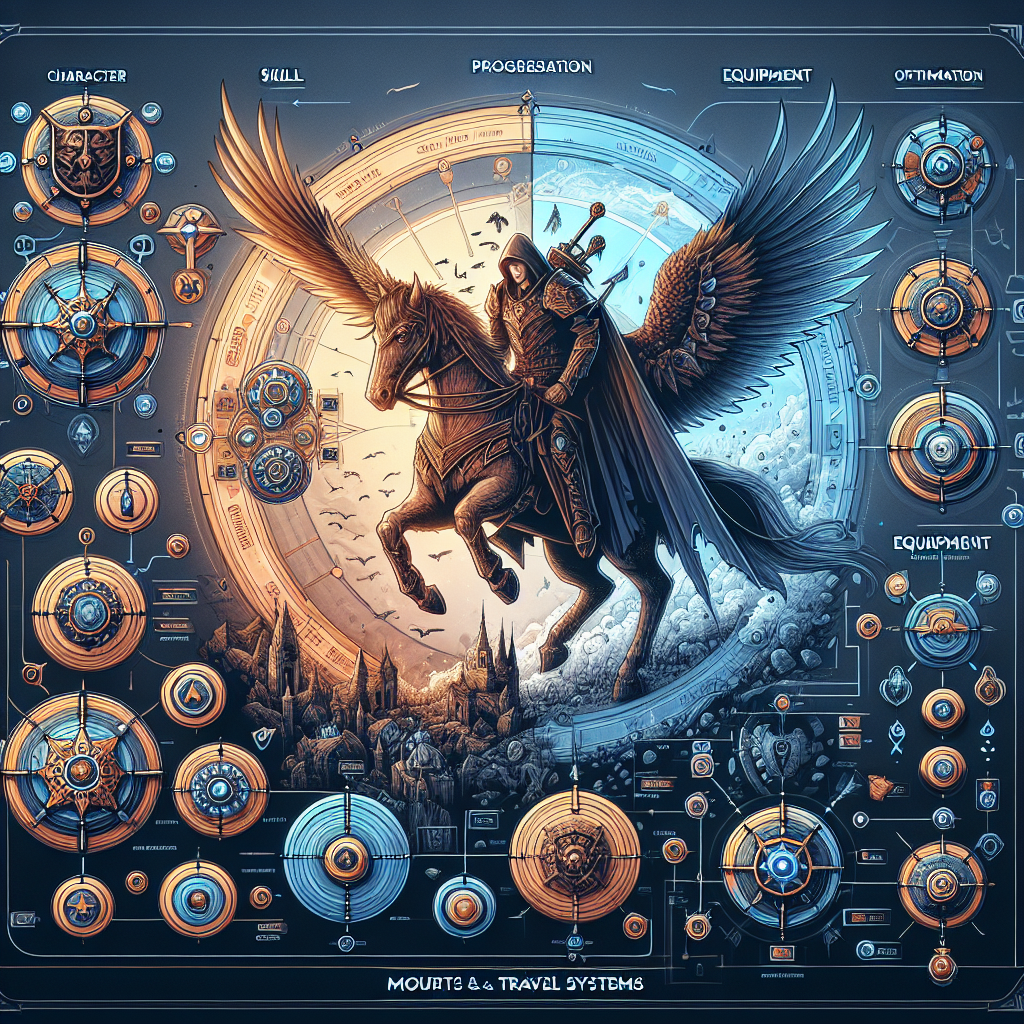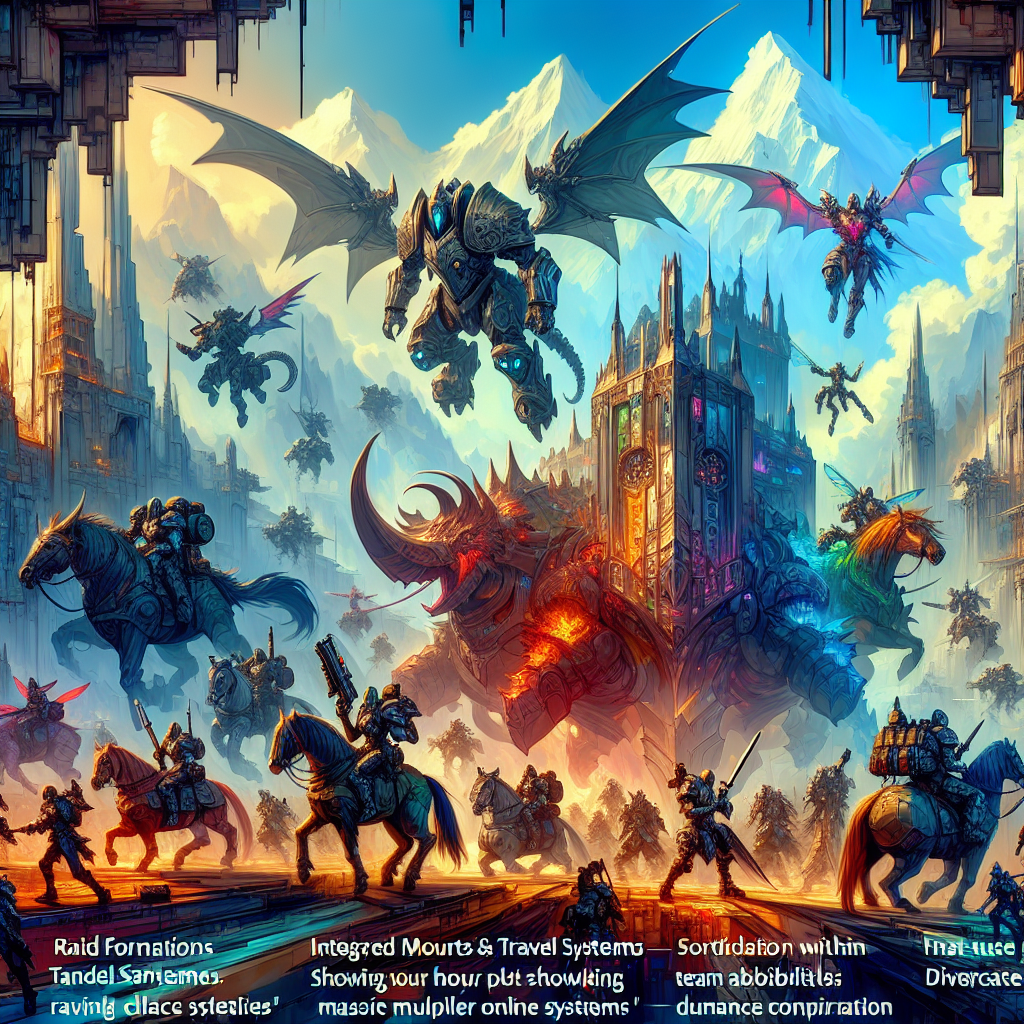How Movement Changes Exploration: The Role of Mounts and Travel Systems in AI-Powered Games
Movement is the fundamental building block of any game world, allowing players to traverse environments, interact with objects, and experience the narrative. In the realm of AI-powered games, the way characters and entities move can have a profound impact on the overall exploration and discovery within the game. Mounts and advanced travel systems are particularly crucial in shaping the player's experience and unlocking new avenues for strategic gameplay and world-building.
The Importance of Mounts and Travel Systems in AI-Powered Games
In AI-powered games, the implementation of mounts and travel systems can dramatically influence the player's sense of agency, the complexity of the game world, and the overall pacing of the experience. These systems not only affect how quickly players can navigate the environment but also introduce new opportunities for tactical decision-making, emergent gameplay, and immersive storytelling.
Enhancing Player Mobility and Traversal
Mounts, whether they be fantastical creatures or advanced vehicles, provide players with increased speed, agility, and access to previously inaccessible areas. This expanded mobility can dramatically change the way players explore and interact with the game world. AI-powered mounts can exhibit unique behaviors, such as the ability to scale vertical surfaces, traverse treacherous terrain, or even fly over obstacles. By leveraging these capabilities, players can discover hidden paths, shortcut through challenging areas, and uncover new vantage points that offer a fresh perspective on the game's environments.
Introducing Diverse Travel Options
Beyond traditional mounts, AI-powered games can offer a wide range of travel systems that cater to different player preferences and playstyles. Fast-travel options, such as teleportation or dimensional rifts, allow players to quickly navigate between distant locations, streamlining the exploration process and enabling them to focus on other aspects of the game. Conversely, slow-paced travel modes, like hot air balloons or sailing ships, can foster a more contemplative and immersive experience, encouraging players to take in the sights and sounds of the game world. The strategic integration of these travel systems can create a layered and dynamic exploration experience, where players must weigh the trade-offs between speed, accessibility, and environmental engagement.
Enabling Emergent Gameplay Opportunities
Mounts and travel systems can also serve as catalysts for emergent gameplay, where players leverage their unique capabilities to devise novel strategies and overcome challenges in unexpected ways. For example, an AI-powered mount with the ability to leap across chasms might enable players to bypass heavily guarded areas or reach previously inaccessible vantage points. Similarly, travel systems that allow players to manipulate the flow of time or teleport between dimensions can open up new avenues for problem-solving, puzzle-solving, and tactical maneuvers.
Designing Mounts and Travel Systems for AI-Powered Games
Crafting effective mounts and travel systems for AI-powered games requires a nuanced understanding of game design principles, AI implementation, and player psychology. Here are some key considerations:
Balancing Mobility and Accessibility
Developers must strike a careful balance between providing players with increased mobility and maintaining a sense of challenge and exploration within the game world. Overpowered mounts or travel systems that trivialize traversal can diminish the sense of accomplishment and the value of player progression. Conversely, travel systems that are too restrictive or punishing can lead to frustration and a lack of player agency. AI-powered mounts and travel systems should offer a range of capabilities that cater to different playstyles and skill levels, allowing players to strategically leverage their strengths while still facing meaningful obstacles.
Integrating AI Behaviors and Interactions
The integration of AI into mounts and travel systems can significantly enhance their depth and dynamism. AI-powered mounts can exhibit unique behavioral patterns, such as the ability to learn and adapt to their rider's preferences, or the capacity to navigate complex terrain autonomously. Travel systems, like teleportation hubs or dimensional rifts, can be imbued with AI-driven logic that responds to player actions, environmental conditions, or narrative events. These AI-powered interactions can create a more engaging and unpredictable exploration experience, where players must contend with emergent challenges and opportunities.
Fostering Narrative and Environmental Storytelling
Mounts and travel systems can be powerful tools for narrative and environmental storytelling in AI-powered games. The design and implementation of these systems can convey information about the game world's history, the culture of its inhabitants, or the underlying lore and mythology. For example, the presence of a particular type of mount may hint at the technological or magical prowess of a civilization, while the availability and distribution of travel systems can reflect the interconnectedness or isolation of different regions. By thoughtfully integrating these elements, developers can create a more immersive and cohesive game world that invites players to uncover its secrets through their exploration and interaction with the various movement mechanics.
Leveraging AI for Optimized Movement and Exploration
AI-powered games offer a unique opportunity to harness the power of artificial intelligence to enhance the player's movement and exploration experience. By integrating advanced AI algorithms and techniques, developers can create dynamic and responsive mounts and travel systems that adapt to player behavior, environmental conditions, and narrative progression.
AI-Driven Path-Finding and Navigation
One of the core applications of AI in mounts and travel systems is the development of sophisticated path-finding and navigation algorithms. These AI-powered systems can analyze the game world's terrain, obstacles, and environmental factors to generate the most efficient and optimal routes for players to reach their desired destinations. This not only improves the overall traversal experience but also opens up new possibilities for strategic gameplay, as players can leverage these AI-driven navigation capabilities to bypass challenges, discover hidden areas, or outmaneuver opponents.
Adaptive and Intelligent Mounts
AI can also be leveraged to imbue mounts with intelligent and adaptive behaviors, creating a more engaging and responsive exploration experience. AI-powered mounts may be able to learn and adapt to their rider's preferences, anticipating their needs and adjusting their movement patterns accordingly. These mounts could also exhibit emergent behaviors, such as the ability to navigate treacherous terrain, evade predators, or even assist players in combat situations. By incorporating these AI-driven capabilities, developers can foster a deeper bond between the player and their mount, further enhancing the sense of immersion and agency within the game world.
Dynamic Travel Systems and Environmental Interactions
AI can also be used to create more dynamic and responsive travel systems that adapt to changing environmental conditions, player actions, and narrative events. For example, teleportation hubs or dimensional rifts could be imbued with AI-driven logic that alters their functionality based on the player's progress, the state of the game world, or even the time of day. These AI-powered travel systems could present new challenges, unlock new pathways, or even introduce unexpected consequences for their use, creating a more unpredictable and engaging exploration experience for players.
Ethical Considerations and Best Practices
As with any AI-powered application, the development of mounts and travel systems in games must be approached with a keen eye on ethical considerations and best practices. Developers must ensure that these systems are designed and implemented in a way that respects player autonomy, promotes fairness, and avoids potential biases or unintended consequences.
Ensuring Accessibility and Inclusivity
Mounts and travel systems should be designed with accessibility in mind, catering to players with diverse abilities and preferences. This may involve incorporating customization options, alternative control schemes, or even the implementation of AI-driven assistive features that adapt to individual player needs. By fostering an inclusive environment, developers can ensure that all players can fully engage with and enjoy the exploration and traversal experiences within the game world.
Mitigating Potential Biases and Exploitation
AI-powered mounts and travel systems must be carefully evaluated to identify and address any potential biases or exploitative tendencies. Developers should carefully monitor the algorithms and decision-making processes underlying these systems, ensuring that they do not perpetuate harmful stereotypes, discriminate against certain player demographics, or create unfair advantages that undermine the overall gameplay experience.
Promoting Transparency and Player Agency
Wherever possible, developers should strive to maintain a high degree of transparency around the workings of their AI-powered mounts and travel systems. This may involve providing players with clear information about the capabilities and limitations of these systems, as well as offering opportunities for players to customize or override the AI's decision-making process. By empowering players and fostering a sense of trust, developers can create an exploration experience that is both engaging and empowering.
Key Takeaways
- Mounts and travel systems play a crucial role in shaping the exploration and discovery experience in AI-powered games, affecting player mobility, accessibility, and emergent gameplay opportunities.
- Effective design of these systems requires a balance between enhanced mobility and maintaining a sense of challenge, as well as the integration of AI-driven behaviors and environmental interactions.
- AI can be leveraged to optimize path-finding and navigation, create adaptive and intelligent mounts, and develop dynamic travel systems that respond to changing conditions.
- Ethical considerations, such as ensuring accessibility, mitigating biases, and promoting transparency, are essential in the development of AI-powered mounts and travel systems.
Final Thoughts
In the ever-evolving landscape of AI-powered games, the design and implementation of mounts and travel systems have the potential to profoundly transform the player's exploration experience. By thoughtfully integrating AI-driven capabilities and leveraging the unique advantages these systems offer, developers can create immersive, dynamic, and engaging game worlds that invite players to discover new frontiers, uncover hidden secrets, and push the boundaries of their strategic thinking. As the field of AI continues to advance, the possibilities for innovative and captivating movement mechanics in games are sure to reach new heights.





